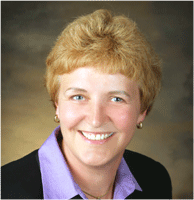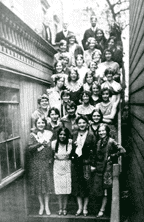The Future of Homeschooling in America
By Sarita Holzmann
Printed in Practical Homeschooling #87, 2009.
 If we are not careful, homeschooling in America may follow the same path as the women’s missionary movement.
If we are not careful, homeschooling in America may follow the same path as the women’s missionary movement.

|

|

If we are not careful, homeschooling in America may follow the same path
as the women’s missionary movement.
The homeschooling movement has thrived for more than thirty years, and
when I have an opportunity to speak to homeschooled high school
graduates, I am impressed with their insightful thinking, their big
dreams, and their heart for the world. They are empowered and equipped
to go out and change their world.
Over these years, the homeschooling movement has been successful at
raising up the next generation of leaders, young people who love the
Lord and seek to serve Him.

|
|
Clementina Butler helped found the Women's Foreign Missionary Society. She served in Mexico and India.
|
In the current homeschool arena, I sense a different emphasis being
presented. Some male speakers seem to imply that husbands need to choose
materials (as the only ones wise enough to do so), that only Christian
books should be read, and that scholarship is less relevant than
spirituality.
I find this a disturbing trend.
I offer a historical analogy as a cautionary tale.
A Brief History of Women’s Mission Societies
At a Perspectives on the World Christian Movement class I attended,
Lorry Lutz, a retired missionary, spoke on the role of women in
missions. She highlighted many stories of wonderful things God has done
through women through the ages. When she came to the 19th century, she
discussed the rise of women’s missionary societies.
After the American Civil War, she said, women were forced, by necessity,
to run the farms and family businesses since many of their husbands—or
potential husbands—had left for the war and/or died in the war.

|
|
Lucy Webb Hayes, the wife of U.S. President Rutherford B. Hayes and first president of the Women's Missionary Society, 1890.
|
At this same time, many women caught a vision to impact their world and
decided to carefully save funds from their household money to give for
world mission outreach.
When traditional missionary boards refused to send single women to the
field, women who had an obvious passion to share Christ with the lost,
thousands of these newly-energized women formed volunteer fund-raising
organizations like the “Cent Societies” (in which members donated one
cent per week for their charitable purpose-a penny acquired by doing
without some small “extravagance” like tea or coffee or a fancy dress)1.
They formed over 100,000 women missionary societies within local
churches and raised funds and prayers. But they went beyond fund-raising
and prayer and organized their own mission boards and built women’s
colleges in order to train women missionaries.
By 1900, over 40 denominational women’s societies existed, with over
three million active women raising funds to build hospitals and schools
around the world, paying the salaries of indigenous female evangelists,
and sending single women as missionary doctors, teachers, and
evangelists. By the early decades of the 20th Century, the women’s
missionary movement had become the largest women’s movement in the
United States, and women outnumbered men on the mission field by a ratio
of more than two to one.2

|
|
Missionary sewing class in Japan, 1925-1926
|
Dr. Ralph Winter, instigator of the modern “unreached peoples” movement
and founder of the U.S. Center for World Mission, says he believes the
strong missions movement of the early 20th century was built on the
sacrificial giving and prayers of these women.
But, said Lutz, “these boards were persuaded to combine with the
denominational boards in the 1920s and 30s,” and “women lost their
opportunity to direct the work.” Over a brief period of time, men took
over leadership of the boards women had competently run for more than
thirty years. And while, no doubt, certain aspects of this take-over had
valid and godly goals (for example, the women’s efforts were less
focused on church-planting, say, than were the denominational boards),
the denominational boards wanted control of the money the women
collected and the power to decide the direction of the agencies.

|
|
Lucy Webb Hayes Bible School and Deaconess Home, Washington, DC, 1891
|
And as the women were moved out of the leadership roles they had
fulfilled so long, they also tragically lost their passion and drive for
missions. All the women who had once worked so hard and sacrificed so
much to support “their” societies disappeared. Few vital,
denominational-level women’s missionary societies still exist. Indeed,
you will be hard-pressed to find many such agencies today.
Why Does It Matter?
I look at this history and wonder.
The homeschooling movement, obviously, has succeeded as men and women,
husbands and wives have worked together. Our earliest forebears in the
movement—usually the men, the husbands—went to jail in order to win us
the right to teach our children at home.

|
|
San Francisco Training School and Deaconess Home, 1891
|
But for all the vital influence and help of these self-sacrificing men,
I don’t think I am misspeaking when I say that the homeschooling
movement was initially galvanized and faithfully staffed primarily by
women. And I know of many mothers, who even without their husband’s
support (for different kinds of reasons) have continued to homeschool
their children at great personal sacrifice.
I tremble that, just as godly men’s desire to take charge of and
override perceived deficiencies in the women’s missionary movement may
have destroyed it, so too, an over-eager desire on the part of
homeschooling fathers to control the homeschooling movement may destroy
the homeschooling movement as well.
Yes, let us listen to the good counsel of these men. But let us also
beware the potential extremes.
May God give us all wisdom and discernment as we seek to pursue His
plans.
SOURCES:
- For a relatively brief but detailed overview of this phenomenon,
see “But Gideon Refused: The Institutionalization of Methodist Mission”
by Jane Donovan of West Virginia University
(are.as.wvu.edu/MissionPaper.htm).
- For more on this, see for example, Johann N. Neem’s Creating a
Nation of Joiners (Harvard University Press, 2008), pp. 90-97 and
“Aspects of the Changing Status of New England Women, 1790-1840” found
at http://sn.im/womenstatus.
Sarita Holzmann, co-founder with her husband of Sonlight Curriculum, is
a speaker, writer, curriculum developer, missions advocate, beloved
wife, former homeschool mom, and grandmother five times over.